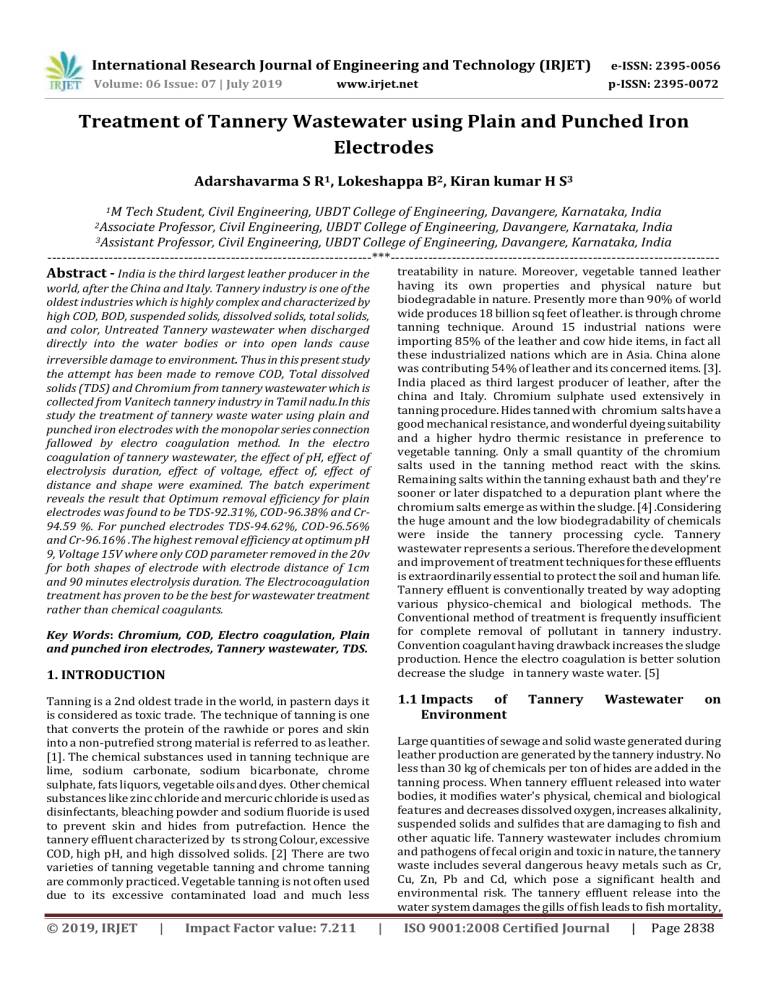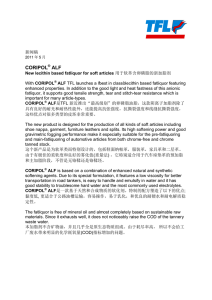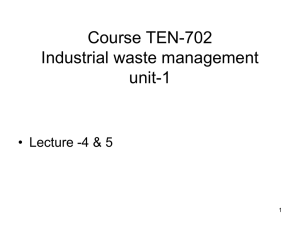IRJET- Treatment of Tannery Wastewater using Plain and Punched Iron Electrodes
advertisement

International Research Journal of Engineering and Technology (IRJET) e-ISSN: 2395-0056 Volume: 06 Issue: 07 | July 2019 p-ISSN: 2395-0072 www.irjet.net Treatment of Tannery Wastewater using Plain and Punched Iron Electrodes Adarshavarma S R1, Lokeshappa B2, Kiran kumar H S3 1M Tech Student, Civil Engineering, UBDT College of Engineering, Davangere, Karnataka, India Professor, Civil Engineering, UBDT College of Engineering, Davangere, Karnataka, India 3Assistant Professor, Civil Engineering, UBDT College of Engineering, Davangere, Karnataka, India ---------------------------------------------------------------------***---------------------------------------------------------------------2Associate Abstract - India is the third largest leather producer in the treatability in nature. Moreover, vegetable tanned leather having its own properties and physical nature but biodegradable in nature. Presently more than 90% of world wide produces 18 billion sq feet of leather. is through chrome tanning technique. Around 15 industrial nations were importing 85% of the leather and cow hide items, in fact all these industrialized nations which are in Asia. China alone was contributing 54% of leather and its concerned items. [3]. India placed as third largest producer of leather, after the china and Italy. Chromium sulphate used extensively in tanning procedure. Hides tanned with ichromiumisalts have a good mechanical resistance, and wonderful dyeing suitability and a higher hydro thermic resistance in preference to vegetable tanning. Only a small quantity of the chromium salts used in the tanning method react with the skins. Remaining salts within the tanning exhaust bath and they're sooner or later dispatched to a depuration plant where the chromium salts emerge as within the sludge. [4] .Considering the huge amount and the low biodegradability of chemicals were inside the tannery processing cycle. Tannery wastewater represents a serious. Therefore the development and improvement of treatment techniques for these effluents is extraordinarily essential to protect the soil and human life. Tannery effluent is conventionally treated by way adopting various physico-chemical and biological methods. The Conventional method of treatment is frequently insufficient for complete removal of pollutant in tannery industry. Convention coagulant having drawback increases the sludge production. Hence the electro coagulation is better solution decrease the sludge in tannery waste water. [5] world, after the China and Italy. Tannery industry is one of the oldest industries which is highly complex and characterized by high COD, BOD, suspended solids, dissolved solids, total solids, and color, Untreated Tannery wastewater when discharged directly into the water bodies or into open lands cause irreversible damage to environment. Thus in this present study the attempt has been made to remove COD, Total dissolved solids (TDS) and Chromium from tannery wastewater which is collected from Vanitech tannery industry in Tamil nadu.In this study the treatment of tannery waste water using plain and punched iron electrodes with the monopolar series connection fallowed by electro coagulation method. In the electro coagulation of tannery wastewater, the effect of pH, effect of electrolysis duration, effect of voltage, effect of, effect of distance and shape were examined. The batch experiment reveals the result that Optimum removal efficiency for plain electrodes was found to be TDS-92.31%, COD-96.38% and Cr94.59 %. For punched electrodes TDS-94.62%, COD-96.56% and Cr-96.16% .The highest removal efficiency at optimum pH 9, Voltage 15V where only COD parameter removed in the 20v for both shapes of electrode with electrode distance of 1cm and 90 minutes electrolysis duration. The Electrocoagulation treatment has proven to be the best for wastewater treatment rather than chemical coagulants. Key Words: Chromium, COD, Electro coagulation, Plain and punched iron electrodes, Tannery wastewater, TDS. 1. INTRODUCTION 1.1 Impacts of Environment Tanning is a 2nd oldest trade in the world, in pastern days it is considered as toxic trade. The technique of tanning is one that converts the protein of the rawhide or pores and skin into a non-putrefied strong material is referred to as leather. [1]. The chemical substances used in tanning technique are lime, sodium carbonate, sodium bicarbonate, chrome sulphate, fats liquors, vegetable oils and dyes. Other chemical substances like zinc chloride and mercuric chloride is used as disinfectants, bleaching powder and sodium fluoride is used to prevent skin and hides from putrefaction. Hence the tannery effluent characterized by its strong Colour, excessive COD, high pH, and high dissolved solids. [2] There are two varieties of tanning vegetable tanning and chrome tanning are commonly practiced. Vegetable tanning is not often used due to its excessive contaminated load and much less © 2019, IRJET | Impact Factor value: 7.211 Tannery Wastewater on Large quantities of sewage and solid waste generated during leather production are generated by the tannery industry. No less than 30 kg of chemicals per ton of hides are added in the tanning process. When tannery effluent released into water bodies, it modifies water's physical, chemical and biological features and decreases dissolved oxygen, increases alkalinity, suspended solids and sulfides that are damaging to fish and other aquatic life. Tannery wastewater includes chromium and pathogens of fecal origin and toxic in nature, the tannery waste includes several dangerous heavy metals such as Cr, Cu, Zn, Pb and Cd, which pose a significant health and environmental risk. The tannery effluent release into the water system damages the gills of fish leads to fish mortality, | ISO 9001:2008 Certified Journal | Page 2838 International Research Journal of Engineering and Technology (IRJET) e-ISSN: 2395-0056 Volume: 06 Issue: 07 | July 2019 p-ISSN: 2395-0072 www.irjet.net and also cause diseases, infertility and birth defects in human beings. It also causes various cancers in animal through food chain. In humans, according to how it is absorbed, chromium creates various ailments cancer. Chromium were inhaled, it acts as a carcinogenic and pulmonary irritant it impacts the upper respiratory tract, obstructs airways, and increases the lung, nasal, or sinus cancer. If dry, cracked and scaled skin causes unprotected handling and contact with tannery wastewater, the erosive ulcerations is known as “chrome holes.” The untreated waste water discharge into water bodies not only effect aquatic life it also effect cattle and vegetative system. It also leads to the pollution of soil, it affects the soil fertility alters soil pH, due to high organic contents it cause clogs to the soil and impair soil structure leads to Soil degradation .[6] Table 1 Initial, characteristics of raw tannery wastewater Sl no 1.2 Theory of Electro coagulation Values 1 Color Brown 2 Temperature °C 240 3 Ph - 8.4 4 Turbidity NTU 727 5 TDS ppm 26000 6 EC Μs 38806 7 BOD, mg/L. 2156 8 COD. mg/L. 6100 9 Chromium mg/L. 14.6 For the batch electro coagulation studies, the reactor will be made from a glass material with the total working volume, of 2 liter and with the dimensions of 22cm x 11cm x 10cm. The electro coagulation unit will be consisting of four electrodes in the reactor and a DC power supply. The I DC source of 030V and 0-2A will be used as the power supply to the system. Plane and punched Iron electrodes having dimensions of 15cm x 5cm x 0.3cm.The distance between the electrodes were kept 1cm and 2cm to studied evaluate optimized distance. One set of electrodes were punched with a 6mm diameter holes. The total of 5 numbers of holes was made. The below figure shows the schematic laboratory experimental set up of electro coagulation Reactions at anode: M n+ (aq) + ne- 2H2O (l) + 2e- Unit 2.2. Experimental Set-up The process of applying electric current in to the aqueous medium in an electrochemical cell using electrode is called electrocoagulation. The principle of electrocoagulation method depends upon, reactions of water pollutants to a strong electric fields and electrically induced the oxidation and reduction reactions. The electrocoagulation uses direct current to remove unwanted pollutants by chemical reactions and precipitation technique. The different types of electrodes used in this process are Aluminium, Zinc, cadmium, Copper, and Iron. [7]. M (s) Parameter 4H+ (aq) + O2 (g) + 4e- Reactions at cathode: M (aq) n+ + ne- M(s) 2H2O (l) + 2e- H2 (g) + 2OH- When aluminum or iron electrodes were used the generated, Fe (aq) 3+ or Al (aq) 3+ ions will instantaneously undergo spontaneous reactions to produces the corresponding hydroxides and polyhydroxides. This hydroxide and poly hydroxide settle in the form of precipitate. 2. Materials and methodology Figure 1 Schematic laboratory experimental set up 2.1 Materials 2.3 Experimental procedure The sample to be studied was collected from a common effluent treatment plant at the Vanitec tannery wastewater treatment plant, Tamil nadu. The sample was collected according to the standards. The sample was preserved at 60C and brings it to the laboratory at standard condition before analysis. The composition of the tannery wastewater are determined using Standard Methods and are presented in Table 1 © 2019, IRJET | Impact Factor value: 7.211 The raw wastewater is diluted to 1in 10 dilution factor before analysis. The monopolar electrodes were arranged in series and connected to a 0-30V and 0-2A DC power supply. Four numbers of electrodes were arranged in series, the end electrodes were connected to positive and negative terminals and the inner electrodes were remains unconnected. The inner electrodes were act as sacrificial | ISO 9001:2008 Certified Journal | Page 2839 International Research Journal of Engineering and Technology (IRJET) e-ISSN: 2395-0056 Volume: 06 Issue: 07 | July 2019 p-ISSN: 2395-0072 www.irjet.net electrodes. A constant gap of 1cm and 2cm was kept between the electrodes. The glass container was filled with 2 liter raw wastewater and the initial pH was adjusted to 7, 8 and 9 to determine the optimum pH .The voltage in the DC power supply was adjusted to 10V, 15V and 20V to evaluate the optimum voltage. The electrolysis was run for 90 minutes. The sample was taken at an interval of 30 minutes. The collected sample was filtered with the ordinary filter paper and analyses the parameter like pH, TDS, COD and chromium as per standard methods. 3. RESULT AND DISCUSSION 3.1 Effect of pH on removal efficiency Figure 3 Effect of pH on removal efficiency The Figure 2 was plotted to study the effect of pH in removal efficiencies of COD, Chromium and TDS. It reveals that removal efficiency of 96.56% COD, 96.16% chromium, 94.62% TDS for pH 9.The chromium ions precipitates in the alkaline range as Cr (OH) 3. TDS and COD also effectively removed at the pH 9 3.3 Effect of operating time on removal efficiency The Figure 4 was plotted to study the effect of, operating time in removal efficiencies of COD, Chromium and TDS. The Figure reveals that as the electrolysis time increases the efficiencies also increases. For the 90 minutes of electrolysis time the efficiencies are as follows COD 96.56 %, Chromium 96.16 % and TDS 94.62 %. Figure 2 Effect of pH on removal efficiency Figure 4 Effect of operating time on removal efficiency 3.2 Effect of voltage on removal efficiency 3.4 Effect of electrode shape on removal efficiency The Figure 3 was plotted to study the effect of voltage in removal efficiencies of COD, Chromium and TDS. It is observed that the COD shows highest removal efficiency of 96.53%, for the voltage 20 the Chromium and TDS have the Efficiencies of 96.16% and 94.62% for Voltage 15. As the electrode potential increases the electrolysis reaction also increases, thereby the iron electrode effectively remove the chromium and TDS at the lesser voltage 15. © 2019, IRJET | Impact Factor value: 7.211 The Figure 5 was plotted to study the effect of electrode shape for the removal efficiencies of COD, Chromium and TDS. The graph reveals that removal, efficiency of 96.56% COD, 96.16%Chromium and 94.62TDS for the Punched electrodes. The punched electrodes provide greater surface area than the plane, as the electrons density would be highest at the sharp edges, more electron accumulate at the holes and edges. These electrons carry more current and subsequently more reactions occur in the solution results in higher efficiency. | ISO 9001:2008 Certified Journal | Page 2840 International Research Journal of Engineering and Technology (IRJET) e-ISSN: 2395-0056 Volume: 06 Issue: 07 | July 2019 p-ISSN: 2395-0072 www.irjet.net treatment”, International Journal of Modern Engineering Research (IJMER), Vol.3, 2013, Issue.1, pp119-122, ISSN 2249-6645. [3] Ramanujam R.A, .Ganesh. R and Kandasamy .J, “Wastewater treatment technology for tanning industry”, Water and wastewater treatment technologies. Vol 4, 2011, pp. 1-17 [4] Alebel Abebe Belay,” Impacts of chromium from tannery effluent and evaluation of alternative treatment options”, Journal of Environmental Protection, vol 1. 2010, pp53-58. [5] Shivayogimath C.B, Prashant Kurdekar, “Treatment of Tannery wastewater by Electrocoagulation”, International Journal of Innovative Research in Science, Engineering and Technology, Vol.3, 2013, Pp379-386. [6] PatelV.G, Uday Mawani , Manoj Bhavsar. “Leather and environment”Environmental information system Vol. 12, 2017, Issue no. 1, pp.1-12. [7] Ramesh Babu, Bhadrinarayana N.S, K.M.Meera Sheriffa Begum, N.Anantharaman,, “Treatment of Tannery Wastewater by Electrocoagulation”, Journal of the University of Chemical Technology and Metallurgy, Issue 42, Vol.2, 2007, pp.201-206. Figure 5 Effect of electrode shapes on removal efficiency 5 Conclusions Based on the above finding the following conclusion are drawn The optimum condition for the removal, of COD, Chromium, TDS from the tannery wastewater using iron electrode was found to be pH of 9, voltage15, electrolysis time 90min, distance 1cm, and punched electrodes with the removal efficiency of 96.56%, 96.16% and 94.62 % respectively. It was observed that, the removal efficiency of COD increased with increase in the pH of the solution time, and voltage whereas other parameter chromium and TDS effectively removed in voltage 15, this voltage is suggested that effectively removed all the parameters Increase in pH was observed during the electrolysis process as the iron electrodes get more dissolution. The alkaline initial pH is best suited for iron electrode getting the maximum removal efficiency It was noticed that the fully turbid brown coloured tannery wastewater sample turned to colourless solution in 60-90 min of electrolysis time, hence 90 minutes electrolysis time is taken as optimum time. For iron electrode it imparts the black colour during electrolysis because of ferric ions. After some time interval the colour were be disappear. The thick sludge deposited on the surface of electrodes was observed. REFERENCES [1] Ebtesam El-Bestawy, Fahad Al-FaSSI., Ranya Amer, Reham Aburokba, “Biological treatment of leather tanning industrial wastewater using free living bacteria”, Advances in Life Science and Technology, Vol.12, 2013, pp.46-65. [2] Saritha Banuraman and Meikandaan.T.P, “Treatability study of tannery effluent by enhanced primary © 2019, IRJET | Impact Factor value: 7.211 | ISO 9001:2008 Certified Journal | Page 2841


